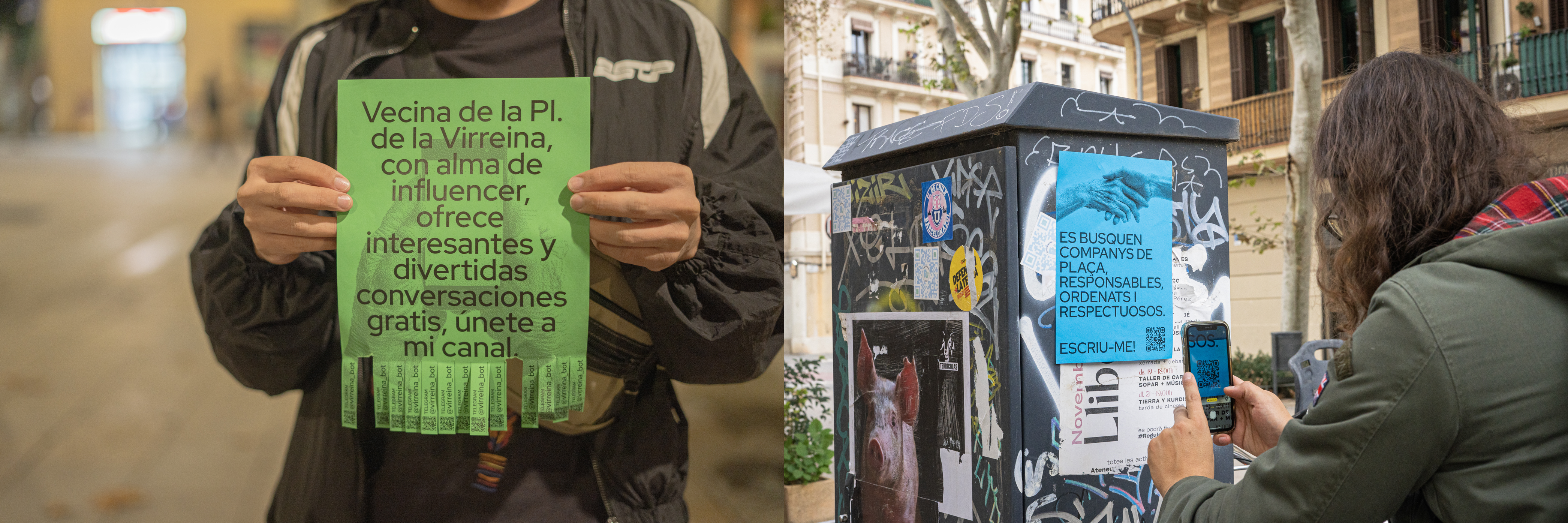Since November 2023, the Front Runner Case (FRC) in Barcelona has been thriving! Insights gathered during the Citizen Observatory onboarding workshop were carefully evaluated, prioritized, and transformed into key actions for 2024.
After an initial assessment, a concrete collaboration was established with the Citizen Observatory LAB CSU (Laboratorio Ciudadano de Salud Urbana) for the local project TÀNIA, an initiative led by Lichen Innovación Social and ISGlobal (Instituto de Salud Global Barcelona). The proposed activities were designed based on the identification of needs by the initiative, leveraging the expertise of the CitiObs partners. Throughout the year, tailored mentoring sessions provided guidance, helping to identify the most effective tools and approaches for overcoming specific challenges.

Citizens at the Ateneu de Fabricació de Gràcia (public makerspace) brainstorming possible creative interventions at the square © Manuela Reyes
Activities of the Front Runner Case Barcelona
One significant challenge identified in Barcelona was noise pollution in Plaça de la Virreina, a lively square in the Gràcia neighborhood. The square is a vibrant gathering space where locals, community members, and tourists enjoy outdoor terraces, socialize, and embrace urban life. However, its popularity has also led to noise-related concerns for nearby residents. The challenge: how to balance the square's dynamic energy with respect for the neighbors' well-being and the environment?
To address this, the FRC Barcelona co-created a creative, citizen-led intervention in the square. The initiative involved a series of collaborative activities, including collective ideation, prototyping sessions, and other co-creation workshops, leading to the creation of a unique interactive fictitious character named Rut.
The first steps were led by the Citizen Observatory (CO) and started with the data collection of noise level patterns by the residents in different locations in the square, including Smart Citizen tool sensors installed in a few balconies. In parallel, qualitative data collection was also carried out through a survey approach called Diagnostico Ciudadano (which translates to Citizen Diagnosis) focusing on identifying the noise perception by the affected people in the surrounding area. Following this, two open calls were launched: the first invited the community to propose solutions for reducing noise levels, while the second, in collaboration with CitiObs and the Distributed Design Platform, invited creative talents willing to support the community in developing the selected idea.
With the initial results in hand, the co-creation sessions began at the inspiring digital fabrication laboratory, Ateneu de Fabricació de Gràcia. These sessions brought together neighbors, professionals, and participants from the CO, guided by experts from the creative sector and supported by advanced technological and digital tools. The goal was to represent the local community while addressing the noise issues in Plaza de la Virreina. Rut served as a symbolic figure to highlight these challenges, fostering empathy and raising awareness among visitors, all while protecting the anonymity of residents by using artificial intelligence tools.

Citizens collectively prototype ideas © Manuela Reyes.
But who is Rut?
Rut is a chatbot powered by a large language model (LLM) and brought to life on Telegram. Her personality was developed through testimonies of different neighbors in Plaça de la Virreina, blending personal stories, experiences, and perspectives to embody empathy. Complementing Rut, other interventions were created with the intention of “making the noise visible”, including a fun offline visual communication campaign. Posters with engaging questions were displayed in many locations of the square, where participants could interact by scanning the QR code which led to the Rut channel on Telegram. In addition to answering questions about the noise in the place, Rut was also calibrated to explain interesting anecdotes and stories from the neighbors and neighborhood. Another feature co-created by the CO was an LCD display for real-time interaction with visitors in the square. This digital tool was built to display phrases related to jokes, interactions, and memories always connected to the topic of noise issues.
Together, these elements form an interactive and creative intervention designed to foster awareness, promote respectful behavior, and maintain the vibrant spirit of the square while addressing noise pollution.

The first prototype of the interactive screen that was later installed at the square in Gràcia © Manuela Reyes

Interactive screen installed at the La Virreina Square in Gràcia © Manuela Reyes.
Impact and Learnings
This exciting citizen-led action has generated invaluable insights for the CitiObs project by showcasing the power of merging diverse skills, such as behavioral change methods, digital tools, and citizen participation, to develop collaborative solutions. Through the use of structured feedback loops, these activities helped to continuously refine and improve both the tools and methodologies available for future Citizen Observatories. The experience in Barcelona demonstrates how creative, community-centered solutions can address urban challenges while empowering local residents.

Creative posters distributed in the square in Gràcia to engage with participants © Manuela Reyes
What’s Next?
Following the successful launch of the CitiObs Alliance cases, the next step is to strengthen collaboration among alliance members. In 2024, both online and in-person gatherings will allow participants to network, exchange ideas, and share experiences. These sessions will offer an opportunity to learn from the CitiObs Front Runner Cases, such as Barcelona, apply improved tools, and refine approaches across different contexts, fostering a shared vision for impactful citizen-led actions.


